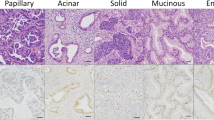Summary
The expressions of p-STAT3 and osteopontin in 22 cases of normal nevi and 43 cases of malignant melanoma were immunohistochemically detected, and the correlation between p-STAT3 and osteopontin in malignant melanoma and the correlations of p-STAT3 (or osteopontin) with invasion, metastasis and thickness of malignant melanoma were examined. The results showed p-STAT3 was expressed in 2 of 22 cases of normal nevi and 30 of 43 cases of malignant melanoma, while osteopontin was expressed in 3 cases of normal nevi and 29 cases of malignant melanoma. The expressions of p-STAT3 and osteopontin in melanoma were significantly higher than that in benign nevi. There existed significant correlations between the expression of p-STAT3 and that of osteopontin in melanoma. Furthermore, the expression rates of p-STAT3 were significantly higher in invasive or metastatic melanomas than that their non-invasive or non-metastatic counterparts, and the expression rates of osteopontin were significantly higher in invasive melanomas than that in non-invasive ones. It is concluded that p-STAT3 and osteopontin may play important roles in the pathogenesis of malignant melanoma.
Similar content being viewed by others
References
Li Y, Mc Clay EF. Systemic chemotherapy for the treatment of metastatic melanoma. Semin Oncol, 2002,29: 413–426
Suiqing C, Min Z, Lirong C. Overexpression of phosphorylated-STAT3 correlated with the invasion and metastasis of cutaneous squamous cell carcinoma. J Dermatol, 2005,32:354–360
Yang SF, Yuan SS, Yeh YT, et al. The role of p-STAT3 (ser727) revealed by its association with Ki-67 in cervical intraepithelial neoplasia. Gynecol Oncol, 2005, 98:446–452
Yang SF, Wang SN, Wu CF, et al. Altered p-STAT3 (tyr705) expression is associated with histological grading and intratumour microvessel density in hepatocellular carcinoma. J Clin Pathol, 2007,60:642–648
Coppola D, Szabo M, Boulware D, et al. Correlation of osteopontin protein expression and pathological stage across a wide variety of tumor histologies. Clin Cancer Res, 2004,10:184–190
Wai PY, Kuo PC. The role of Osteopontin in tumor metastasis. J Surg Res, 2004,121:228–241
Denhardt DT, Mistretta D, Chambers AF, et al. Transcriptional regulation of osteopontin and the metastatic phenotype: evidence for a Ras-activated enhancer in the human OPN promoter. Clin Exp Metastasis, 2003,20:77–84
Balch CM, Buzaid AC, Soong SJ, et al. Final version of the American Joint Committee on Cancer system for cutaneous melanoma. J Clin Oncol, 2001,19:3635–3648
Horvath CM. STAT proteins and transcriptional responses to extracellular signals. TIBS, 2000,25:496–502
Heimberger AB, Priebe W. Small molecular inhibitors of p-STAT3: novel agents for treatment of primary and metastatic CNS cancers. Recent Pat CNS Drug Discov, 2008, 3:179–188
Kortylewski M, Jove R, Yu H. Targeting STAT3 affects melanoma on multiple fronts. Cancer and Metastasis Reviews, 2005,24:315–327
Chakraborty G, Jain S, Behera R, et al. The multifaceted roles of osteopontin in cell signaling, tumor progression and angiogenesis. Curr Mol Med, 2006, 6:819–830
Senger DR, Perruzzi CA, Papadopoulos A. Elevated expression of secreted phosphoprotein I (osteopontin, 2ar) as a consequence of neoplastic transformation. Anticancer Res, 1989,9(5):1291–1299
Philip S, Bulbule A, Kundu GC. Osteopontin stimulates tumor growth and activation of promatrix metalloproteinase-2 through nuclear factor-k B-mediated induction of membrane type I matrix metalloproteinase in murine melanoma cells. J Biol Chem, 2001,276:44926–44935
Rangaswami H, Kundu GC. Osteopontin stimulates melanoma growth and lung metastasis through NIK/MEKK1-dependent MMP-9 activation pathways. Oncol Rep, 2007,18:909–915
Shijubo N, Uede T, Kon S, et al. Vascular endothelial growth factor and osteopontin in tumor biology. Crit Rev Oncog, 2000,11(2):135–146
Xie TX, Wei D, Liu M, et al. Stat3 activation regulates the expression of matrix metalloproteinase-2 and tumor invasion and metastasis. Oncogene, 2004,23:3550–3560
Satoshi L, Cynthia DB, Gary EG, et al. Inhibition of Src kinase activity by ad-mda7 suppresses vascular endothelial growth factor expression in prostate carcinoma cells. Mol Ther, 2005,12:707–715
Senger DR, Ledbetter SR, Claffey KP, et al. Stimulation of endo-thelial cell migration by vascular permeability fac-tor/vascular endothelial growth factor through cooperative mechanisms involving the avh3 integrin, osteopontin, and thrombin. Am J Pathol, 1996,149:293–305
Chakraborty G, Jain S, Kundu GC. Osteopontin promotes vascular endothelial growth factor-dependent breast tumor growth and angiogenesis via autocrine and paracrine mechanisms. Cancer Res, 2008,68(1):152–161
Author information
Authors and Affiliations
Additional information
The two authors contributed equally to the project.
Rights and permissions
About this article
Cite this article
Wu, Y., Jiang, P., Lin, Y. et al. Expression of phosphorylated-STAT3 and osteopontin and their correlation in melanoma. J. Huazhong Univ. Sci. Technol. [Med. Sci.] 29, 246–250 (2009). https://doi.org/10.1007/s11596-009-0223-0
Received:
Published:
Issue Date:
DOI: https://doi.org/10.1007/s11596-009-0223-0




